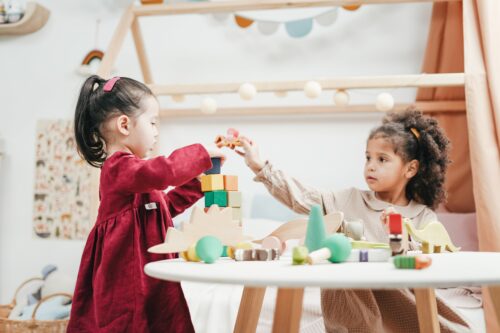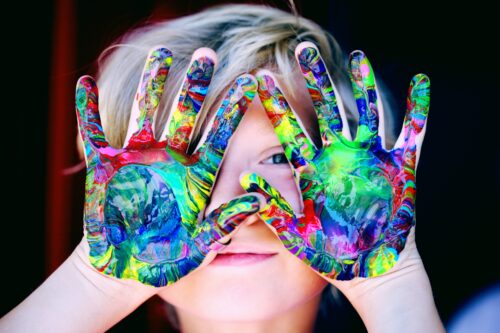Imagine a world where the giggles and imaginative adventures of children are not just a part of playtime, but a gateway to healing and growth. This world exists in the realm of play therapy. Play isn’t just an association for play therapy. Instead, play therapy is a language that speaks volumes about a child’s inner world.
During early childhood, words often fall short. So, something really cool called play therapy comes in. It’s like a special way for kids to show their feelings, learn new things, and feel better. We’re going to learn all about how important it is for helping kids grow up happy and healthy.

The Principles Of Play Therapy
Play therapy operates on a set of core principles. As a form of clinical practice, these principles guide its practice and effectiveness. At its heart, play therapy is an interpersonal process that believes play is a fundamental, natural behavior. It provides a comfortable and familiar medium through which they can express feelings, thoughts, experiences, and behaviors.
The program of play therapy involves special training to different people such as school counselors, mental health professionals, and those in the field of professional psychology.
The key principles include:
Communication Through Play
Children often struggle to articulate their feelings and thoughts verbally. Play therapy utilizes children’s play as a language of communication. Through play, children can express what is troubling them when they cannot find the words to do so.
Safety And Trust
Creating a safe and supportive environment is crucial in play therapy. This sense of safety allows children to explore, express, and experiment without fear of judgment. It’s about building trust between the child and the play therapist.
Child-Centered Approach
Play therapy emphasizes the importance of following the child’s lead. When kids feel safe, they can try new things, share their thoughts, and play in different ways without worrying about someone being mean or not understanding them. It’s like making a special friendship with the person who helps them, where they can trust and feel comfortable.
Holistic Development
The therapy focuses on the holistic development of the child. It addresses social, emotional, behavioral, and cognitive aspects, to resolve psychosocial difficulties and to achieve optimal growth and development.
Therapeutic Relationship
The relationship between the therapist and the child is fundamental. A strong, empathetic relationship enhances the therapeutic process, facilitating deeper engagement and effectiveness.
Types Of Play Therapy
There are various types of play therapy, each tailored to meet different needs and situations. Some of the most common therapy techniques include:
Directive Play Therapy
In this approach, the therapist leads the session, directing activities and guiding the child through specific therapeutic play. It is often used when a child needs help to address a particular issue or to learn specific skills.
Non-Directive Play Therapy
Here, the child leads the play, with the therapist following and facilitating rather than directing. This approach is grounded in the belief that children have the innate ability to resolve their own problems and that play helps to unlock this potential.
Group Play Therapy
Conducted with groups of children, this form of therapy helps in:
- Developing social skills
- Learning to work in groups
- Understanding how to manage interpersonal relationships
Creative Arts In Play Therapy
This approach incorporates various forms of creative arts, including drawing, painting, music, and drama, into the therapy process. It’s particularly effective for children who respond well to artistic and creative expression.

Sandplay Therapy
Sandplay therapy utilizes a sandbox, water, and miniature figures to create scenes that reflect a child’s inner thoughts, concerns, and struggles. It’s a non-verbal, imaginative form of pretend play therapy.
Storytelling And Narrative Play Therapy
Here, children are encouraged to create and tell stories, which can reveal their perceptions, experiences, and issues. It’s an effective way to understand a child’s inner world.
Each type of play therapy has its unique attributes and is chosen based on the individual needs and circumstances of the child.
The Role Of Play In Child Development
Play therapy with children is not just a leisure activity; it is a vital element in their developmental journey. It serves multiple roles in fostering the growth and well-being of a child. Understanding these roles helps to appreciate why play, and by extension, play therapy, is so crucial in child development.
1. Emotional Development
Play allows children to express and process their feelings in a safe and constructive way. Through play, they can explore a range of emotions, from joy and excitement to fear and anger. It’s a natural outlet for expressing emotions and working through experiences.
2. Social Skills Development
Through interactive play, children learn vital social skills such as communication, cooperation, and empathy. Play scenarios often involve:
- Negotiation
- Understanding others’ perspectives
- Sharing
All these are essential skills for social interaction.
3. Cognitive Growth
Play stimulates cognitive development and learning. It encourages curiosity, imagination, and problem-solving skills.
Activities like building blocks, puzzles, and role-playing games enhance cognitive abilities, including memory, concentration, and decision-making.
4. Physical Development
Physical play, such as running, climbing, and jumping, is crucial for developing motor skills, balance, and coordination. It also promotes overall health and well-being.
5. Language And Communication Skills
Play involves a lot of verbal and non-verbal communication. Through play activities, children learn to:
- Articulate their thoughts
- Listen to others
- Use language effectively
5. Creativity And Imagination
Play is a fertile ground for creativity and imagination. Children use play to create their own worlds, scenarios, and stories, fostering imaginative thinking and creative problem-solving.
6. Self-Discovery And Identity
Play provides opportunities for children to explore different roles, scenarios, and experiences. This exploration is key to understanding themselves, their likes, dislikes, strengths, and limitations.
7. Therapeutic Benefits
For children undergoing stress, trauma, domestic violence, behavioral disorders, eating disorders, or developmental challenges, play serves as a therapeutic medium.
It helps them process difficult experiences and feelings in a non-threatening environment.
8. Learning And Academic Skills
Play is often an early introduction to basic academic concepts like numbers, colors, shapes, and letters. Educational play activities lay the foundation for formal learning and academic success.
9. Resilience And Coping Mechanisms
Through play, children learn to cope with challenges, setbacks, and failures. It builds resilience and the ability to adapt to new situations.
Play Therapy For Specific Issues
Play therapy is not a one-size-fits-all approach; it is tailored to address specific issues that children may face. Its flexibility and adaptability make it suitable for a wide range of challenges:
Anxiety And Stress
For children experiencing anxiety, cognitive behavioral play therapy offers a safe and non-threatening way to explore these feelings. Therapeutic play helps them express their worries and learn coping strategies to manage anxiety.

Trauma And Loss
Children who have experienced traumatic events or significant loss often struggle to verbalize their feelings.
Play therapy provides a way for them to process these complex negative emotions through symbolic play, gradually working through the trauma in a controlled, safe environment.
Behavioral Challenges
Children with behavioral difficulties, such as aggressive behavior, defiance, or hyperactivity, can benefit from play therapy. It helps them learn:
- Self-regulation
- Empathy
- Appropriate ways of expressing emotions and frustrations
Developmental And Learning Disabilities
For children with developmental or learning disabilities, play therapy can be tailored to their specific needs, helping them develop social and communication skills and improving their self-esteem and sense of achievement.
Autism Spectrum Disorders
Play therapy can be particularly beneficial for children on the autism spectrum, providing them with a way to improve social interaction, communication, and emotional expression in a structured yet flexible environment.
Family And Relationship Issues
Children affected by family issues, such as divorce or sibling rivalry, can use play therapy to explore their feelings about these situations and learn healthier ways to interact and communicate with family members.
Integrating Family In Play Therapy
Family involvement is a critical component in the success of child’s play and therapy. Integrating family members into the therapy process can enhance the therapeutic outcomes and foster a supportive environment for the child.
1. Family Sessions
Involving family members in some play therapy sessions can help them understand the child’s world.
These sessions provide a platform for family members to engage with the child in a controlled, therapeutic setting, fostering stronger bonds and mutual understanding.
2. Parental Guidance
Therapists often provide guidance, play materials and training to parents on how to continue the therapeutic power of play at home. This approach helps in reinforcing the benefits of therapy and maintaining consistency in the child’s environment.
3. Observation And Feedback
Parents and caregivers can be involved in the therapy process through observation and feedback. This involvement helps them understand the child’s behavior and progress, as well as how they can support their child’s development outside of therapy sessions.
4. Home-Based Play Activities
Assigning home-based play activities that involve family members can be an effective way to extend the therapeutic benefits into the home environment.
These activities encourage continued emotional and social development.
5. Family Dynamics Understanding
Play therapy sessions involving family members can provide valuable insights into family dynamics and relationships, helping the therapist to tailor the approach to meet the specific needs of the child within the context of their family environment.
Incorporating family into play therapy not only supports the child but also empowers the entire family unit, fostering a more harmonious and understanding home environment.
To Wrap Up
As we finish learning about how modes of play therapy work and how important it is for kids to grow up, we see how amazing and strong every child is. Play therapy isn’t just a way to help; it’s really about how playing, being creative, and understanding feelings can make kids’ hearts and minds feel better. It’s like a bright light showing kids how to understand their feelings and what they go through.
When kids play, they get really good at talking about how they feel, making new friends, and becoming brave. This helps them be happier as they get older. From what we’ve learned about play and therapy, we can see it’s not just great for kids, but it also makes the whole world nicer.
Frequently Asked Questions (FAQ)
How does play therapy help a child?
What are the techniques of child centered play therapy?
What is role play in therapy with children?
What are the three basic functions of play therapy?
What is the goal of play therapy?
How does play help mental development?
How does play help mental development?
What is the role of play in child assessment and intervention?
How do you teach social skills in therapy?
What is an example of role play in teaching?
What is the role of client play therapy?
What are the goals of play therapy for trauma?
Is play therapy good for autism?
